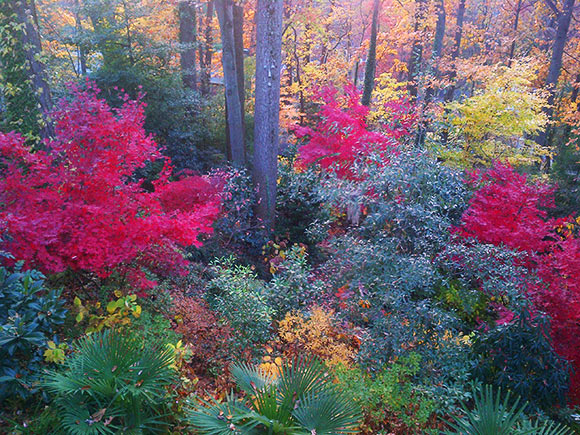Dear clients and Friends,
This is the week the Bloodgood Japanese Maples are in their Autumn prime: cherry/fire engine red—brilliant! They are the last hurrah in my Autumn garden and a perfect segue into the holiday season with their bright, red color. With these sunny, mid-November days, it’s almost painful to pull myself away from my garden or back windows! I know the leaves will be down before I know it, so I savor the time I have with the fleeting color. I don’t know why the color is such a surprise every year—this is about the fifteenth year I’ve had them in this garden, and each year, the color takes my breath away, once again. Once those red leaves finally drop off the trees, I know the growing season has ended and it’s time to clean up for the Winter.
To me, the color of the Bloodgood Maples is just about the best. ‘Bloodgood’ Japanese Maple (Acer palmatum ‘Bloodgood’) is one of my top favorite small trees. I’ve had a lot of them planted in my career (that’s around 30 years of planting). They are not the smallest of small trees—if you look around right now, you’ll see some big, fat mature ones, and they are not for the smallest gardens (they could completely dominate a small, courtyard garden in Old Town Alexandria, for instance—not something for everyone—though to imagine a garden with a ceiling of cherry red in the Fall is something to imagine!). I’ve seen them around 25 feet tall by around 15 to 20 feet wide at maturity. The branching structure is open and magnificent; the bark is dark and the trees look fantastic uplit at night, especially now—they look like cherry drops. The leaves emerge a coppery-red in Spring and settle into a nice, burgundy-green for the Summer, more burgundy some Summers than others, depending on the weather. I once planted one for a client in Annandale, at the beginning of my career, in the early 1980s. Though I was newly taken with Bloodgoods at the time, I didn’t know all the nuances. The client called that Summer, demanding I replace the tree because it wasn’t “red enough”, and he wanted it red! I researched it, and found out that Bloodgoods need to root well before showing their best colors. Luckily, my client was willing to hang in there, and the tree is now mature and spectacular (and burgundy in the Summer!) year-‘round.
And in our fast-forward, I-want-it-now, instantaneous society, waiting is not an easy thing to do. But with gardens, wait we must. In my experience, it takes three years for plants to get established; they take off that third year, and they are really growing by the fifth. (The old saying for English Ivy is, “It sleeps [year one]; it creeps [year two]; it leaps [year three].” I think that’s a good general rule for all trees and shrubs, too.) I think one of the payoffs of ripe, middle age and beyond is that time seems to pass so increasingly fast—a benefit when you are wishing your garden to grow, at least, if for no other reason! The wait is worth it. The payoffs are great. So are the surprises. Delightful.
Next story > A Year of Writing

